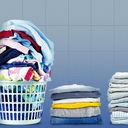"Women's work" could soon be officially measured in government data

The Labor Department might soon start tracking an often overlooked part of the economy: "women's work."
Why it matters: Unpaid household labor like child care, laundry or home repairs is critical to the economy but isn't officially measured.
State of play: Economists at Bard College released a report this week detailing how the government could measure this activity, which they call "household production."
- The Labor Department commissioned the report in 2021, part of a major initiative aimed at coming up with a new component for one of its biggest reports, on consumer expenditures.
- That survey examines how much Americans spend on everything from food to furniture to restaurant meals.
It doesn't capture activities that don't cost money — but do cost time.
Stunning stat: Women performed 78% of the total value of unpaid household production in 2019, the researchers found.
- That number reflects "the patriarchal allocation of household production responsibilities in our society," per the report.
The big picture: It's important to track this kind of data to understand so many things — like Americans' true cost of living, explanations for the pay gap, and women's lower labor participation rates.
- The measure could be particularly crucial in refining measures of poverty.
Flashback: When day cares and schools shut down during the height of the pandemic, Americans got a crash course in how critical unpaid labor is for keeping society humming. That experience nudged the Labor Department into action.
Between the lines: This is a win for feminist economists. For years, their mainstream peers, mostly men, argued unpaid work wasn't an economic issue because it's a woman's moral duty borne out of love.
Zoom in: To measure household production, the Bard economists looked at data from the census and other places, mainly from 2019, on how Americans spend their time. They paired this with Labor Department numbers on how much certain work costs.
- For example, they looked at hours spent doing child care and at wages for child care workers and pre-K teachers.
- In a novel twist, the economists measured different kinds of child care — active work, like reading to a child, and supervisory work, keeping an eye on the kids while you're doing laundry or something else. They also looked at unpaid work done by non-household members, like grandparents or aunts.
- The aim is to convert the hours spent on tasks into a measurable value.
What's next: The Labor Department will evaluate the methodology used in this report with a goal of adding a household production measure to its expenditure data in 2025.